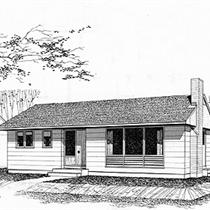Besides architects and planners, the modernist town planning ideas also permeated to social welfare advocates, and politicians. In Nova Scotia, several town planning acts and municipal legislation were passed to allow towns to implement planning and zoning. This local legislation and support from prominent citizens and leaders was as much an enabler of these ideas as the architects and planners.
During the post-war period, CMHC served as the federal government’s housing arm.

CREDIT: Handout photo courtesy of CMHC Small House design catalogue
Central Mortgage and Housing (CMHC) was formed in 1946 to promote and provide housing for returning veterans. It was a natural change from the wartime housing board, which was created to house soldiers and their families.
CMHC was set up as a Crown corporation to administer the 1944 National Housing Act. The act was a piece of legislation that allowed municipalities to enter into agreements with the federal government “to assist in the clearance, re-planning, rehabilitation and modernization of blighted or substandard areas”. The act also stated that “the federal and provincial governments may assist municipalities in carrying out urban renewal schemes which can include both commercial and residential redevelopment, and residential rehabilitation”.
In its first years of existence, Central Mortgage and Housing, provided mortgage insurance to banks to encourage them to lend money so that people could purchase homes. Later CHMC was also extensively involved in housing design and produced plan books of houses under the Small House Program. (Pictured: CHCH Small House design, look familiar?)
Parliament amended the National Housing Act in 1954. Now Properties could be developed for their highest and best use, including commercial uses. This was a big difference over previous versions of the act, which only allowed clearance of slum housing to make way for new housing.
The act set out several conditions for federal support:
- the proposed area must be blighted
- the project must be in harmony with official community plans
- make the highest and best use of the land
- a substantial part of the area must be residential
- fair provision must be made for dwellings for displaced families
- the province must approve
- the municipality must clear the land, the federal contribution will not be more then half the cost
- the federal government shares in the revenue in proportion to contribution
- Central Mortgage and Housing will act as agent for the federal government
The CMHC Small house program was begun In 1947. The Small House program was explicit, in that the designs were for modern suburban houses. The housing program was attempting to be distinctly Canadian, and while borrowing from British modernism, American inspiration was rejected. this meant embracing the garden city ideals and modern planning principles. CMHC was now powered by an amended national housing act encouraging clearance of blighted urban slum areas, and a program to develop and encourage affordable suburban homes.
By March of 1968, there were thirty-seven renewal projects at an estimated cost of $180 million. CHMC Architects and planners were responsible for the design of many of the projects, including Mulgrave Park in Halifax, and its prototype, Regent Park in Toronto. It was in partnership with CHMC, that the city undertook Stephenson’s 1957 redevelopment study for Halifax. The partnership was further enhanced by the fact the city’s Development Officer, Robert B. Grant, was a former CMHC official.







